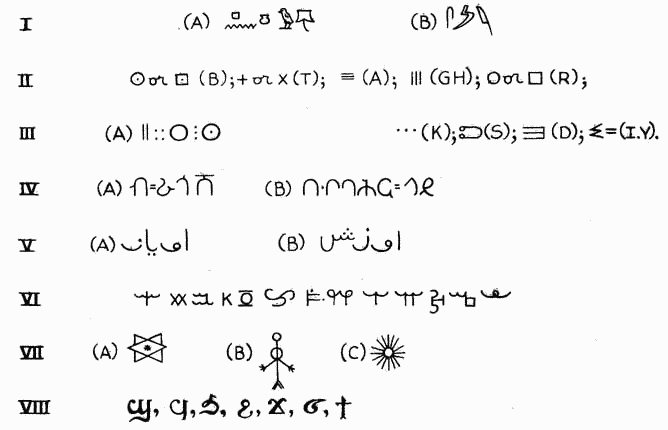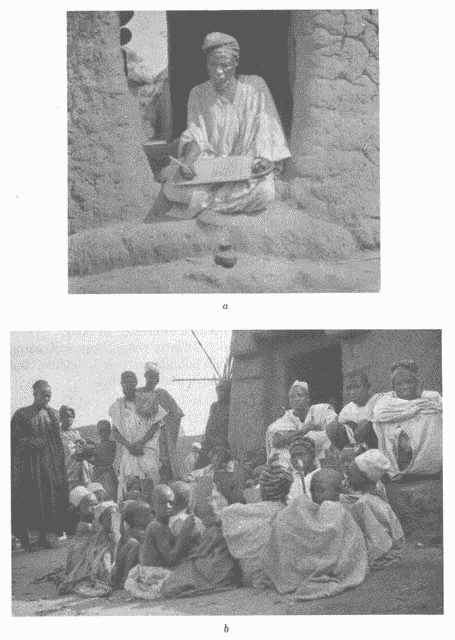WRITING (Table 9)
I. Egyptian hieroglyphs: (A) pennu, mouse; (B) sma, to slay. II. Libyan. III. T’ifinagh: (A) naught but good. IV. Amharic: (A) river; (B) island. V. Arabic: (A) a game; (B) fifteen. VI. Vai, each character is a syllabic sign. VII. Nsibidi: (A) Very great love between husband and wife. The center star denotes a warm and loving heart; (B) A slave with his hands tied together; (C) The sun. VIII. Seven symbols that were added to Greek characters for the writing of Coptic.
 TABLE 9 SPECIMENS OF AFRICAN WRITING
TABLE 9 SPECIMENS OF AFRICAN WRITING
The Hamitico-Semitic languages—Egyptian, Arabic, Libyan, and Amharic—have written characters, but the only attempts of Negroes to invent a script are those of the Vai in Liberia, the Bamum in Cameroons, the Efik near Calabar, and a tribe of Sierra Leone (Sumner, 1932). Of these scripts, Egyptian and Arabic are the most important. The former, first as hieroglyphs, then as cursive writing, gives a detailed history of social and religious development in Egypt from at least 3500 B.C. onward. Arabic later takes up the story of events in north Africa, the Sudan, and the east coast from A.D. 700 to modern times. Events of Abyssinian history are recorded in Amharic, while Greek, Roman, and Coptic have preserved historical records for late Egyptian and north African history. Yet these chronicles leave by far the greater part of African history unrecorded. As a general introduction to a study of African script Hoffman (1895) and Mason (1920) will be found useful.
The beginnings of Egyptian writing are unknown, but six thousand years ago pictures were used to represent words, and this cumbersome method evolved into a cursive hand called hieratic, which in turn gave way to demotic. Each change represented a simplification and a further conventionalizing of the original hieroglyphic characters.
In the hieroglyphic system, a draughtboard set with pieces meant a game of draughts, but at a later stage in the development of Egyptian writing the same drawing conveyed the idea of "being set." The pictograph had developed into an ideograph; then came a phonetic stage in which the written character appealed to both the eye and the ear of the reader. Thus, a picture of a human arm primarily meant an arm; later, the syllable heb, "arm," could be represented by the picture of an arm to stand for the sound heb in any word in which that sound occurred.
An ingenious use of symbols known as determinatives was combined with the use of phonograms, and at the end of the word a picture was added. For example, at the end of the phonograms giving sounds for the word "woman" a kneeling figure of a woman was drawn, to avoid making mistakes in the interpretation of the phonetically spelled word. At the end of the phonograms for the word "eating," a picture showing a man with his hand to his mouth was added. In Table 9, example I A, a hide with tail attached is a determinative for the word "mouse."
By the second century of the Christian era the Egyptian language was represented in Greek characters, though some demotic signs were retained, and two hundred years later, Coptic, in which parts of the Bible were written, was generally used (Table 9, example VIII). The Egyptians themselves attributed the origin of their writing to the god Thoth, who is represented with a pen and a writing tablet. Rationalizing by means of explanatory myths is usual among people who wish to explain the presence of certain important cultural elements. The Egyptians had stories to explain not only the invention of writing, but the apparent journey of the sun, eclipses of the moon, and other phenomena.
No reason exists for supposing that Egyptian writing was imported from outside Egypt, though the speech contains triliteral roots, which are characteristic of Semitic tongues, and there are Hamitic features as well. Decipherment of Egyptian hieroglyphs and other forms of writing did not begin until the year 1802, when a trilingual inscription in Greek, hieroglyphs, and demotic was deciphered from a slab known as the Rosetta Stone. Since that time scholars have concentrated on the translation of inscriptions from monuments and papyri.
Oric Bates (1914) states that no inscription in Libyan characters has yet proved older than the fourth century B.C. The chief center of Libyan culture was west of the Nile, and the dispersal of culture was westward to the Canary Islands.
Study of Libyan inscriptions (Table 9, examples II and III) leads to the conclusion that the Libyans adopted characters from Phoeni-clan script, and to these signs they added enough owners’ marks to make an alphabet, which despite its crudity was adequate for their needs. Libyan inscriptions are read from below upward, beginning usually with the right-hand column. More rarely the inscriptions are horizontal; then they are read from right to left (Mélix, 1892; Bertholon and Chantre, 1912, vol. 2, pp. 503–518).
Bertholon and Chantre have prepared a tabular statement in six columns showing the similarity of some symbols used in T’ifinagh, Libyan, Cretan-Egean, Cypriote, Archaic Greek, and Etruscan. Chantre points out that the most ancient traces of Libyan writing are rock inscriptions, possibly funerary, and some of these are perhaps as early as the Neolithic period in north Africa. According to Chantre, the history of our study of Libyan characters is traceable to the discovery of a bilingual inscription on a stone found at Dougga in the seventeenth century. As a source book for the study of Libyan and Punic, Chantre gives the "Revue Africaine" (especially Tome 4, pp. 154–237), published by the Société Historique d’Alger.
Some Libyan characters have been incorporated in T’ifinagh, the script in which Tamashek (Temajegk), the language of the Tuareg, is written. F. R. Rodd (1926, p. 267) states that Ifadeyn Tuareg, both male and female, still read and write Tamashek. They use the script for messages and for inscribing records of visits on trees and rocks. Some present-day writing of the Tuareg (Table 9, III) is composed of personal or tribal marks grouped together; but the difficulty of deciphering inscriptions in T’ifinagh is due to the fact that they may be written to read up or down, from left to right, or from right to left. H. R. Palmer (1932) connects T’ifinagh script with the Sabaean characters of south Arabia and those of the Ethiopic alphabet. He believes that the Tuareg first entered the Sahara, A.D. 300–600, bringing camels from the eastern Sudan.
Amharic, an ancient Semitic tongue, has been the official written language of Amhara, the central province of Abyssinia, since A.D. 1300. Amharic is written in Ethiopic characters (Brauner-Plazikowski, 1914, Cohen, 1936), but the use of this language has been too restricted to assist with general problems of African history (Table 9, IV).
Arabic (Table 9, V A and B) is now the official language of Egypt and many parts of north Africa. The history, philosophy, religion, poetry, and folklore of the Arabs are contained in many books and manuscripts, and Arabic is used in modern newspapers of Egypt. Historical documents and correspondence in Arabic show an ornate style. The former begin with, "In the name of Allah, the compassionate, the merciful," and the latter have a complimentary introduction, "To the Great and Glorious Governor, peace be unto thee, and the mercy of God and his blessing." On the outside of the folded paper may be written, "To reach, if it please God, the hand of . . . ;" then follows the name of the recipient.
In Mohammedan schools children may be seen seated on the ground before their mallam, who instructs them in writing Koranic texts on smooth boards with ink and reed pens, after which the texts are chanted in unison (Fig. 61). Arabic is used for writing Hausa, Mandingo, and Swahili, but E. Steere (1908) states that Arabic characters will never be able to express the sounds of Swahili. The reason for this is that Swahili has five vowels and Arabic has only three. Arabic supplies no characters for the Swahili consonants ch, g, p, or v.
The Vai of Liberia, who are ethnologically part of the Mandingo people, have a script that Koelle of the Church Missionary Society
 FIG. 61. Mohammedan education. a. Mallam of Bida, Nigeria, writing Koranic texts. b. School in Kano market, Nigeria.
FIG. 61. Mohammedan education. a. Mallam of Bida, Nigeria, writing Koranic texts. b. School in Kano market, Nigeria.
traced to the independent invention of Bukere, a Vai who died in the year 1850. Bukere stated that he had a dream in which a white man appeared and explained to him the use of writing. Bukere then noted all the sounds in the Vai language and gave to each sound a sign. Inspection of the 160 characters indicates that these are of independent origin; the script does not appear to be related to any system of calligraphy, African or otherwise. An editorial note in HAS, vol. 1, 1917, p. 292 gives important data relating to the history of the Vai script, and a facsimile of the first published script is shown.
The Vai signs have changed in form and number to some extent since their invention, but they still provide a script that has been used for writing parts of the Bible and the Koran. The characters are mainly geometrical, but some pictographs exist. A circle with dots for eyes and a stroke for a mouth represents a human head, while a stick and twisted lines symbolize fire (Migeod, 1909; Massaquoi, 1911; Klingenheben, 1933; Johnston, 1906, vol. 2, pp. 1116–35). For a sample of Vai characters see Table 9, example VI.
When the chief Njoya of the Barnum tribe of Cameroons was a youth of sixteen years, his father became interested in books, chiefly the Koran, carried by Hausa traders. In later years Njoya instructed his officers to invent signs to express sounds in their language, and from this collection he chose the most useful symbols.
Njoya purchased slates and made himself a teacher of the script, and Malcolm (1920b), quoting Goring (1907), states that six hundred natives were able to read and write the new characters. Njoya kept a record of events in this script, and he used it for keeping tally of purchases. H. H. Johnston, in his preface to Malcolm’s article, states that the Bamum script resembles Vai writing, and that some of the signs are trade-marks from packing cases, and with this opinion L. W. G. Malcolm agrees (Malcolm, 1920; O. G. S. Crawford, 1935; Labouret, 1934b).
In the year 1905, T. D. Maxwell, District Officer at Calabar in east Nigeria, discovered a secret primitive writing among the Efik. The characters are to some extent pictographic, though the signs have become so conventionalized that their meaning is not apparent. The script takes the name of a powerful secret society, Nsibidi, to which only chiefs might belong. Messages were sent in Nsibidi (Table 9, example VII), whose characters were cut or painted on palm stems. The characters of this script are painted on the faces of girls by their female relatives. P. A. Talbot (1912, p. 320) states that "sometimes a girl’s life history is proclaimed in this manner." The Ekoi assert that the script was taught by monkeys who sat round their campfires. Certain signs represent a trial before the courthouse, which is shown as an oval, while the executioners are indicated by five symbols, each formed like a letter T. This script is used for writing complete stories, some of which are shown by Talbot in pictures of Nsibidi accompanied by translations. Articles by Macgregor (1909) and Dayrell (1911) give further information about the script Nsibidi.